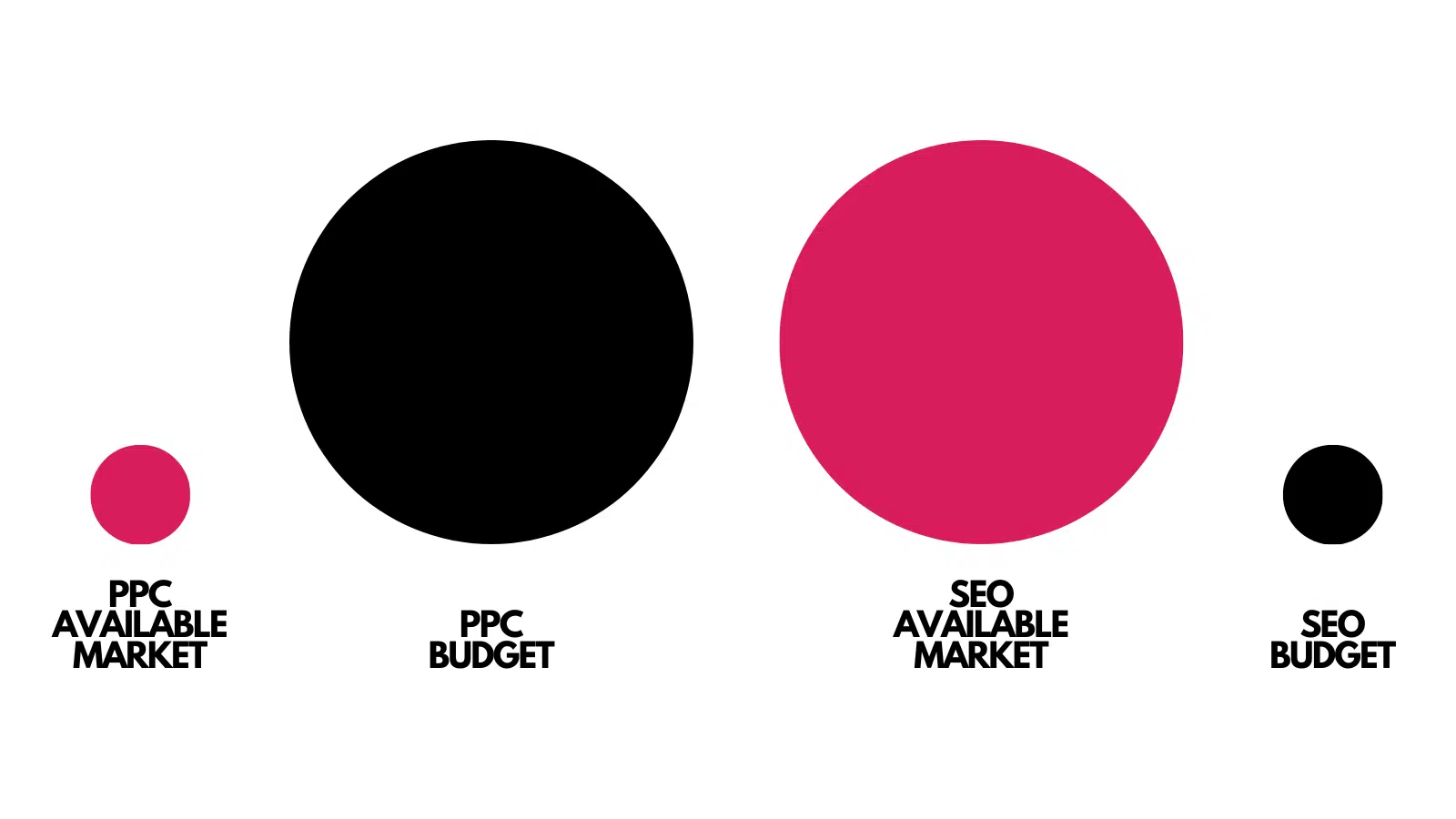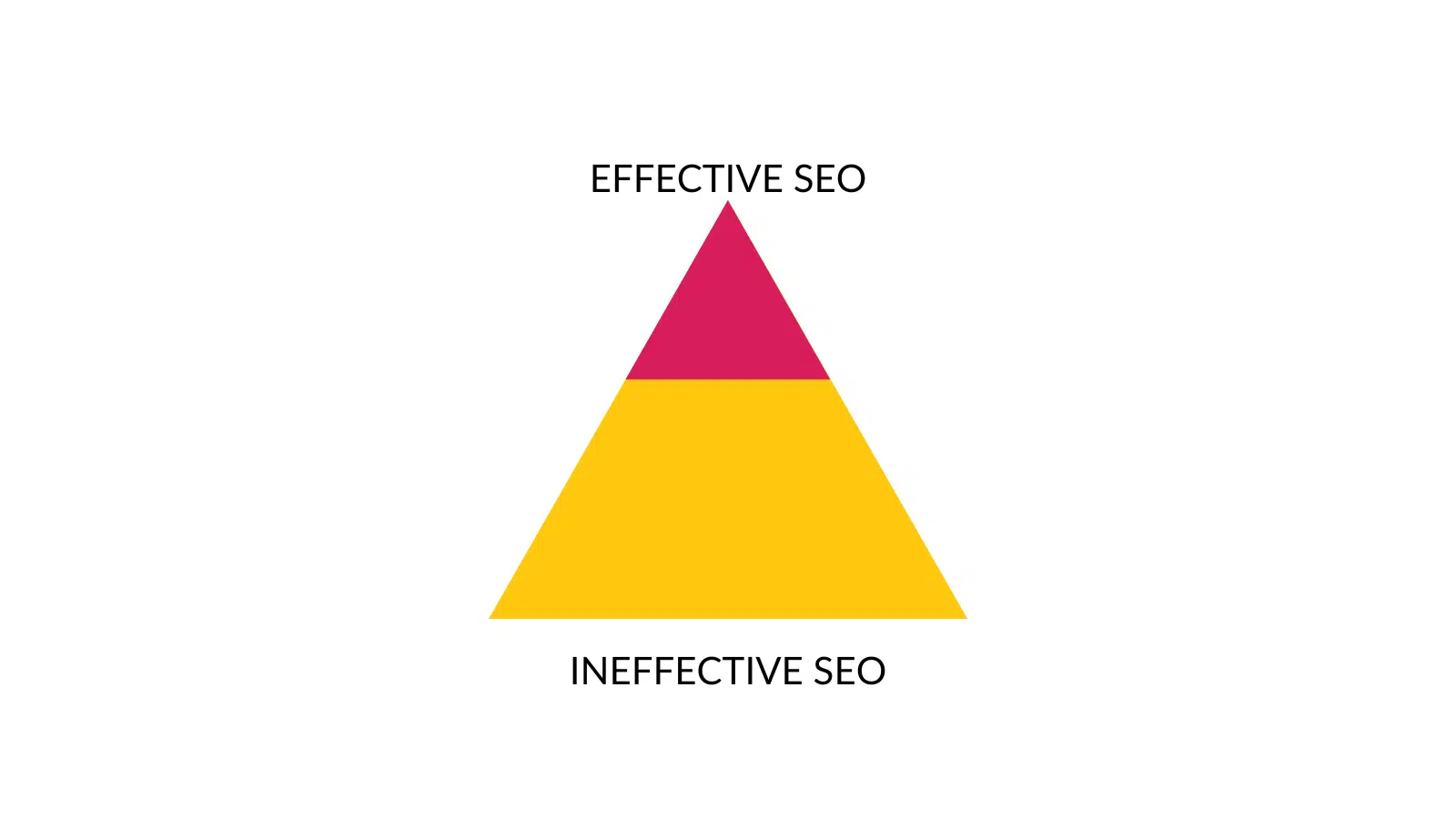Every day, we hear marketers talk about the ROI of SEO.
In this article, I’ll explain why we must stop thinking like that.
Why ROI is a dangerous

Over recent years, thanks to work by marketing experts such as Tom Roach, I’ve dug into the concept of ROI in marketing.
In particular, the ROI of SEO.
After all, the term has been used to terminate SEO retainers and even stop them from occurring.
So, if we throw a term around, we need to understand precisely what it means.
Thankfully, Tom has handily broken it down:
ROI is the net profit generated by your activity divided by the total cost of that activity.
Profit = Costs / Total costs
And this is where we run into difficulties.
Because ROI is a measurement of efficiency rather than effectiveness.
Yes, ROI is a ratio. Not a sales figure.
And this is where ROI starts to fall apart and is dangerous to use for SEO.
Budget realism
For most SEOs, the idea of getting a six-figure budget is in the land of dreams.
Yes, most SEOs are still in the $500 to $2,000 per month model.
But why?
This is largely because SEO is the worst sell in marketing.
“If you pay now, you’ll get results in 6 to 12 months. Oh, and we don’t guarantee results”.
This immediately triggers the risk-averse, and so people pluck their budgets out of thin air.
And if you’ve been in SEO for a while, you’ll have heard this line.
“We want to start small, and if we see some returns, we’ll invest more.”
And this is where things start to fall apart.
Because SEO doesn’t work like that.
You’re either investing to get the job done, or you’ll waste money.
Dig deeper: What percentage of your budget should go toward SEO?
Monthly reporting: The destroyer of ROI
There’s nothing like being the last agency a client uses.
When you’re the last SEO agency in a succession, much of the work has probably been done.
The client is within the top 11-15 for their core terms, and with a bit of a nudge, everyone wins, and off you skip to the SEO awards.
In reality, before that, the previous three or four agencies all tried and did a bit of work.
Each agency built upon the last, and each promised results.
The issue is that there needed to be more budget or the money was spent on the wrong things.
Regardless, clients quickly tire when monthly reporting shows little to no results or progress.
And here lies the core issue for SEO.
The less you pay, the longer it takes for results to come.
This brings us to the next issue with ROI.
You don’t get returns on investment until you rank
So there you have it: the client signs the retainer and awaits the SEO to do their magic.
And here lies the issue.
Distance.
As I said earlier, being the last agency is fun. Being the agency before this can be tough.
Because there is always a starting point.
This means that there is going to be a certain amount of time before the client ranks, and then they can start to see some results.
And this becomes the low-investment death loop of SEO.
Clients want to see some returns before they invest more. So, they invest a small amount.
The website needs more authority and is too far away from the buyer intent keywords to generate results.
The client terminates the agency and moves on to another, repeating the low investment. And either through sheer time, they eventually rank or give up on SEO entirely.
And so goes another retainer, the graveyard of ROI.
SEO is an investment in your business, and like many investments, it takes time to bring returns.
Dig deeper: Why next year’s SEO results depend on your SEO work this year
Get the daily newsletter search marketers rely on.
People don’t know what ROI actually means
London Business School marketing professor Tim Ambler states:
“ROI was devised for assessing capital projects where the investment is made once, and the returns flow during the following years.”
And this is a core issue when people look at the ROI of SEO.
What they usually mean is “sales.”
Clients log into their analytics dashboards and try to attribute sales of some kind to organic search.
ROI is not a monthly sales increase.
SEO increases business profits, but we measure it on sales
Most people turn to SEO to increase the leads or sales coming into their business.
And why do people want that? Because more sales will mean more money coming into the business.
But the real power of SEO is that it places a business in front of people in the market to buy without paying per click.
And, due to the nature of PPC (paid search), which seeks to reduce waste by targeting only the most likely to buy today. SEO reaches people researching the category and more of today’s buyers due to the higher organic click-through rates.
Simply put, SEO places your business in front of more prospects, and you don’t pay per click.
In addition, SEO also allows you to reduce the need to spend on paid search.
You can start to see how SEO works.
- It increases sales volume by reaching more buyers.
- It reduces the need to spend on paid search.
- It reduces the dependence on paid search.
The above increases a business’s profits.
Dig deeper: How long SEO takes to work
You don’t measure the performance of SEO through ROI – you justify its investment
When I consult, I always ask what businesses spend on paid search.
It’s almost always a lot.
And so, this is what SEO does.
Its ROI is to reduce the paid search spend and increase sales volume.
So, if you’re paying $100,000 a year on paid search, the ROI of the SEO is to reduce the need to spend that $100,000.
You also reach more buyers without paying per click, so you’ll increase sales, which increases profits.
So, you justify the cost of investing in SEO through ROI. You just don’t measure its performance that way.
So, how do you measure its performance?
Measure SEO effectiveness, not ROI

When it comes to SEO, there is a lot of noise. But when you use the word “effectiveness,” you drown that noise out.
Because effectiveness can be directly linked to the goal of generating more business profit.
But a word of warning: you can only judge the effectiveness once you are ranking for your buyer intent keywords.
That’s when you start the clock.
And after a decent enough period (which will depend on purchase cycles), you can then stop and measure its effectiveness.
Which should show up in your turnover.
Remember, sales count, not credit for sales. We’re not trying to break down where the last click came from, but rather that sales have increased since organic rankings occurred.
Effectiveness, not vanity metrics

I need to point out something here.
The effectiveness of SEO to grow the sales (and profit) of a business is what is key.
I keep seeing SEOs talk about conversion to become an “email subscriber.”
And while yes, that is a conversion technically, all you’ve really done is grow your email list.
You have to nurture this lead through emails over time and hope they convert down the road.
This is not the best way for brands to leverage SEO, and indeed, the cost of doing SEO to grow email lists should be compared with other methods, such as Facebook advertising.
Traffic is vanity. Profit is sanity.
Regarding performance SEO, the question is a simple one.
Is SEO an effective way to increase profits and turnover?
And then you can figure out what your returns have been.
But we need to speak about investment.
Dig deeper: How to determine the SEO metrics that matter
SEO is a sunk cost
I haven’t mentioned forecasting in this article.
Mainly because it’s mostly a waste of time, and if we’re honest, if a business is being propped up by paid search, the forecast is arguably quite simple.
If you’re not using SEO to grow, you’ll have to find another way, or you’ll stagnate/ plateau.
This is why ROI is such a dangerous thing to measure SEO performance around.
Because you’ll look to reduce your risk and try and scale investment based on perceived returns.
Every business wants the perfect world of getting $5 back for every $1 you spend on marketing. But the world isn’t perfect.
SEO is a sunk cost.
Once you have decided to invest in SEO, the money is gone.
If results haven’t happened, this is where you need to assess the effectiveness of the SEO agency, staff or freelancer.
And your budget.
All of which are sensible and logical discussions to have.
It’s entirely right to speak to management and suggest that the budget isn’t sufficient to get the desired results.
Every business must understand that SEO is like winning Wonka’s golden ticket.
It’s a competition where the ones on top of the SERPs started long before you, and they have spent far more money to get there. And spend money to stay there.
But it’s a growth tactic and should be financed like that. Not a “test.”
The rules of SEO are simple.
- You justify investment in SEO through ROI potential.
- You measure performance through rankings for buyer intent keywords and share of search.
- And once you’re ranked, over time, you can measure the impact of SEO through profit and turnover.
Measuring the performance of SEO through ROI is a little like measuring the success of your children while they’re at school.
Or, to put it even more bluntly.
If you spend $100,000 a year on paid search, you’ll spend half a million in the next five years.
SEO can massively reduce and potentially save you $500,000.
But it can’t do that with a small monthly budget and people asking, “Where’s my ROI?”
If you are going to invest in SEO, make sure the budget matches the problem and the potential.
SEO can double or triple your turnover while reducing your paid search costs. All of which will increase profits.
But it needs time, proper investment and SEOs to use an effective strategy.
And when all of the above happens, the magic in SEO takes place.
Opinions expressed in this article are those of the guest author and not necessarily Search Engine Land. Staff authors are listed here.
Source link : Searchengineland.com
